GPS-60C ColorMap
Display and Setup Screens
The G60C is a departure from Garmin's
recent effort to "segment" the market by producing GPS receivers which
are application specific. Garmin has Marine units, Hiking units,
Car Navigator units, Beginner's Units and a host of "grey" units in between.
In its time, the GPS-12xl was a "GPS for All Uses". I believe
the G60C will be the "GPS for all uses" in its time. Below we show
you over SIXTY different display and setup screens. Don't let this
scare you. The user can select/de-select what screens he wants to
have in the normal screen rotation and change them at will. In the
displays below, there is a sentence or two below each group of four
pictures with a brief explanation of the screen's function. For more
details on how to use a GPS-60C receiver, download the manual from HERE
Main
Screens in the PAGE screen rotation
1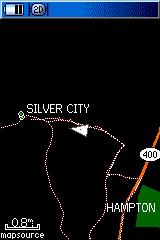
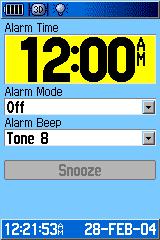
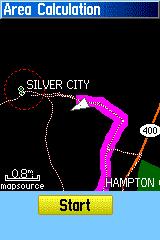
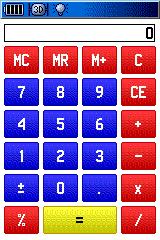
1a) Basic map screen showing both roads traveled and
the dotted lines are tracklog dots.
1b) Alarm Clock function page which allows alarm time
setting and alarm tone selection.
1c) Area Calculation screen which allows you to compute
the area inside a tracklog.
1d) Calculator screen that can be used to do simple math
calculations.
2
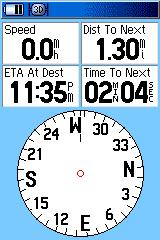
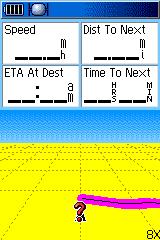
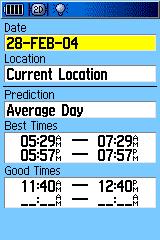
2a) Calendar display. Click the bar at the top
to move back or Forward in time.
2b) Compass display. Data fields are user selectable.
2c) 3D Highway display. Data Fields are user selectable.
2d) Hunting and Fishing Guide (Don't bet on it!)
3
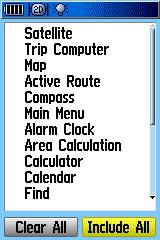
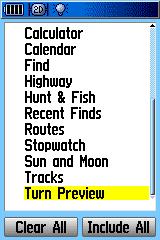

3a) Tracklog list and setup page. You can save
an existing track by clicking on Save.
3b/c) List of available screens which can be put into
the Page/Quit key rotation sequence.
3d) Satellite screen showing what satellite signals are
being received and their strength.
4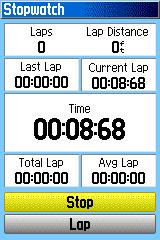
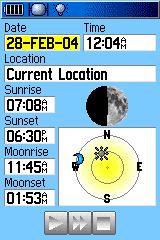
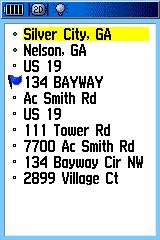
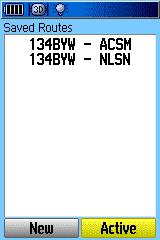
4a) Stopwatch screen which allows laptimes and total
times.
4b) Sun and Moon data screen.
4c) Waypoint List screen. You can select one, press
enter for waypoint details.
4d) Listing of Saved Routes screen.
5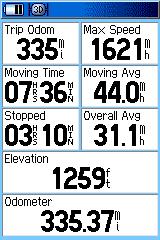
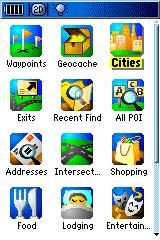
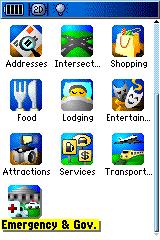
5a) Travel Computer Screen. Max Speed is from the
last Concorde Flight. 
5b/c) List of Destination Source Options for automatic
car navigation entry.
SYSTEM SETUP SCREENS
6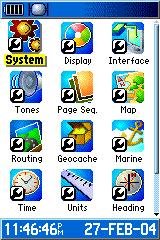
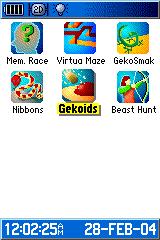
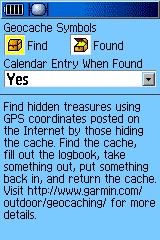
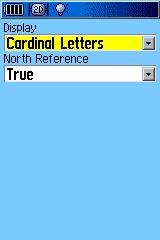
6a) SETUP options which are displayed when SETUP is selected
from the Main Menu.
6b) Available Games which, when selected, can be played
on the GPS unit.
6c) GeoCacheing Screen. Here you can store and
review stored Geocache entries.
6d) North Display selection screen. You can select
E or 90 and True/Magnetic options.
7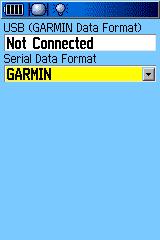
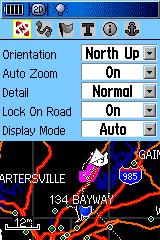
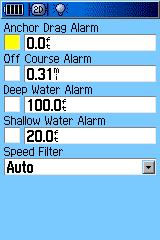
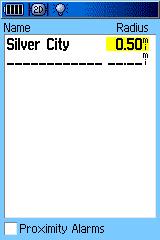
7a) Interface selection/status display screen.
7b) Map Screen in Setup mode.
7c) Setup screen for the Marine mode options.
7d) Proximity alarm setup page. Shown is alarm
if the unit gets within 0.5 miles.
8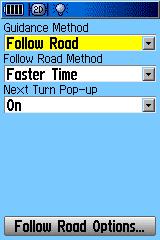
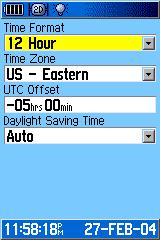
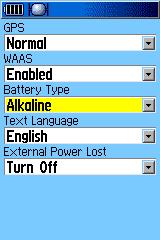
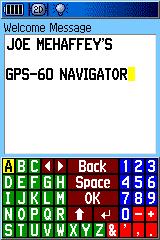
8a) Guidance Method Setup screen for Car Navigation.
8b) Time Format, Time Zone setup screen.
8c) GPS Options setup screen.
8d) "Welcome Page" setup screen.
9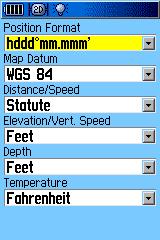
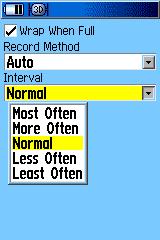
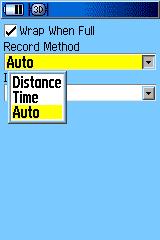
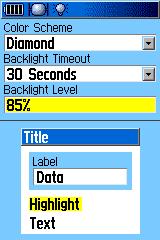
9a) Position Options setup screen.
9b/c)Tracklog options setup screens.
9d) Display setup screen. There are 8 color schemes
to choose from. This one is "diamond".
The
following is a summary of how destination addresses can be input to the
Garmin GPS-60C
10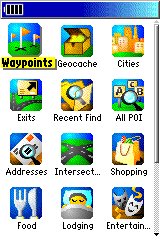

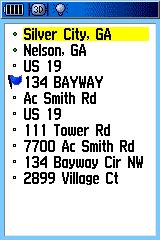
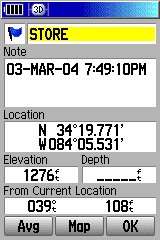
10a/b) First you select one of the optional sources of
destinations from these possibilities.
10c) One option is a previously input-by-user list of
"Recent Finds" destinations.
10d) When you press the MARK key, you store a waypoint
for your present location. This can then be used to generate a route
when needed.
11
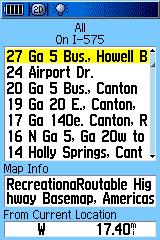

11a) Optional list is of cities nearest your current
location.
11b) Option is a listing of Recreation Areas nearby.
11c) Option is a listing of local "Points of Interest".
You get a mixture here.
12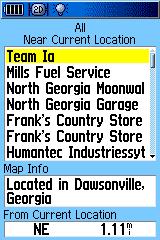

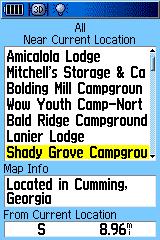

12a) Optional listing is of local shopping locations.
12b) Optional listing is of local food markets and restaurants.
12c) Listing is of local lodging. Mitchell's Storage
seems misplaced.
12d)
Listing is for Government and Emergency Services.
13


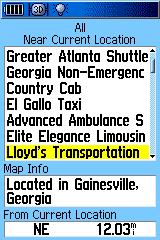
13a) Local entertainment attractions. We have a
lot of horses in our area.
13b) Local "attractions".
13c) Local "services".
13d) Local transportation services.
ENTERING
A STREET ADDRESS INTO THE GPS-60C
14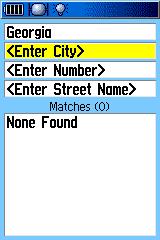
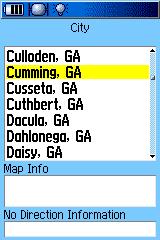
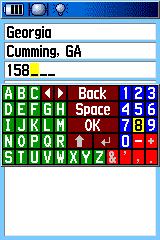
14a/b) Entering
an actual ADDRESS is another option for selecting a Destination.
First we select "enter city" press enter on the GPS and then use the keyboard
to enter the first few letters of a city name. Up comes a page (14b)
showing a list of cities.
14c) Then a street NUMBER is entered using the same keyboard
used for City Name entry and select OK then ENTER.
15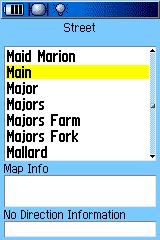
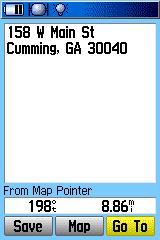
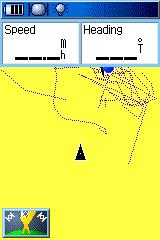
15a) Then select "Enter Street Name" in 14a, and
press ENTER. Then Enter the first few letters of the street name
using the same keyboard as in 14c). Press OK then ENTER when your
streetname appears in the 15a) display. Scroll to your street and
press ENTER. Then image 15b appears.
15b) Here you can either SAVE the address, or press MAP
to view the destination on the map or just press GO TO for automatic routing
to begin.
15c) This map display with the small lower left image
indicates that the route to your selected destination is being computed.
The G-60C is quite fast and most local routes of 50 miles or less take
from 5 to 15 seconds.
Routing Notes:
1) The turn screens "pop up" as a turn is approached
and return to the normal map screen as you pass the turn.
2) The user can select either NORTH UP or TRACK
UP for the main map, but the pop-up screens are always TRACK UP.
3) If you fail to follow the directions,
the GPS will automatically recalculate a new route as soon as it realizes
you are "off route".
4) If you stop at (say) a restaurant, when
you return and restart the GPS, it will automatically recalculate
and take you on the rest of your route.
5) "Road Routing" is the default. If you
want to use the G-60C on a hiking adventure, you must select the
OFF ROAD option in MAP SETUP (go to MAP page and press MENU, on MAP tab,
turn LOCK ON ROAD to OFF) or the G-60C will try and route you from waypoint
to waypoint using nearby roads. ALSO: You must select OFF ROAD
in ROUTE PREFERENCES in the ROUTING SETUP tab in the MAP SETUP menu.
6) Faster Time seems to always give me better
automatically generated routes than the Shorter Distance option.
B) The OFF ROAD mode of operation
As noted in item #5 immediately above, you must select the
OFF ROAD mode of operation. This mode is used for hiking and marine
activities. In this mode, the routes do NOT lock to roads and
the compass page is changed in format to similar to the G-V and other general
purpose Garmin GPS units.
SPECIAL
MAP SYMBOLS FOR USER WAYPOINTS
16

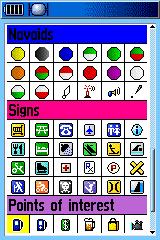
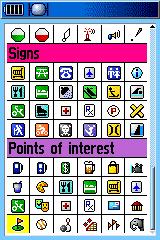
16) The above windows show the variety of special map
symbols which can be used with waypoints and geocache waypoints to indicate
the type of location being marked. This is the largest assortment
of map symbols we have seen so far in any GPS recevier.
TRACKLOG
SCREENS
17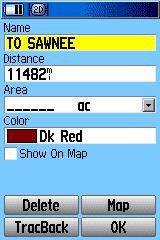


17a) Saving a Track page. You can save a
tracklog, give it a name and a color when displayed.
17b) A saved Tracklog can be used to trackback in off
road mode.
17c) The user can setup the tracklog to drop trackpoints
on time, distance or automatic.
GEOCACHING SCREENS
18
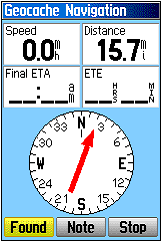
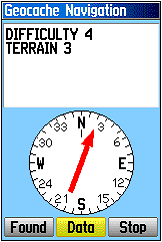
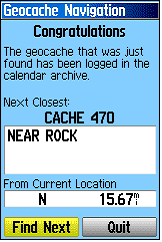
18a) The GeoCache setup screen.
18b) When GeoCache mode is enabled, the Comapss
Screen changes to the special GeoCache Mode.
18c) If notes about a GeoCache are included, they can
be displayed by clicking on NOTE.
18d) When a GeoCache is found, that fact is stored and
then you can go on to the next one.
ROUTE
GUIDANCE and Typical MAP SCREENS
19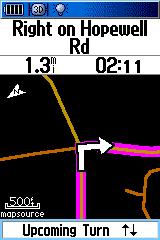
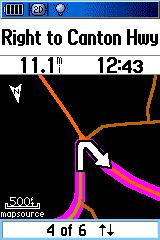
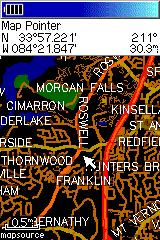
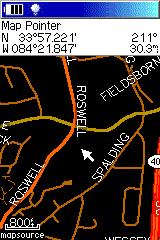
19a/b) The user can explore a computed route and look
at the turns to come. Above are shown the "next" turn and the 4th
of 6 turns on the current route. This is essentially the same picture
that appears when the GPS is approaching the next turn in an executing
automatic route.
19c/d) Typical street maps shown at maximum detail.
20
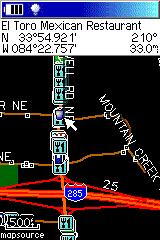
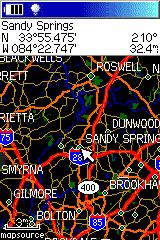
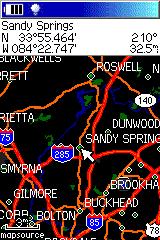
20a) Another typical street map showing detail at 0.2
mile scale.
20b) The same area as 20a) at 500ft scale showing restaurants
and services along Roswell Road
20c/d) Road maps at HIGHEST detail and NORMAL detail
settings.
21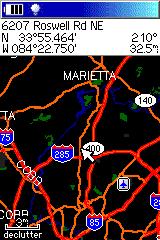
21a) The same map as 20d) but with map DECLUTTER turned
ON.
Return
to top of GPS-60C product Review
Click HERE to return
to Joe and Jack's GPS Information Website Main Page








































































